Related Research Articles
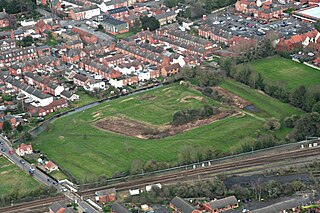
Sleaford is a market town and civil parish in the North Kesteven district of Lincolnshire, England. Centred on the former parish of New Sleaford, the modern boundaries and urban area include Quarrington to the south-west, Holdingham to the north and Old Sleaford to the east. The town is on the edge of the fertile Fenlands, 11 miles north-east of Grantham, 16 mi (26 km) west of Boston, and 17 mi (27 km) south of Lincoln. Its population of 17,671 at the 2011 Census made it the largest settlement in the North Kesteven district; it is the district's administrative centre. Bypassed by the A17 and the A15, it is linked to Lincoln, Newark, Peterborough, Grantham and King's Lynn.

North Kesteven is a local government district in Lincolnshire, England. The council is based in Sleaford. The district also contains the town of North Hykeham, which adjoins the neighbouring city of Lincoln, along with numerous villages and surrounding rural areas.
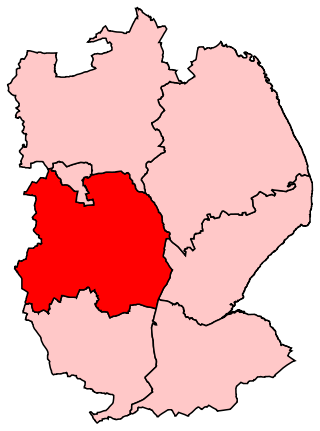
Sleaford and North Hykeham is a parliamentary constituency in Lincolnshire, England which elects a single Member of Parliament (MP) to the House of Commons of the UK Parliament. It has been represented since 2016 by Dr Caroline Johnson, who is a member of the Conservative Party. The seat was created in 1997 and has always been represented by Members of Parliament (MPs) from the Conservative Party; like all British constituencies, it elects one candidate by the first-past-the-post voting system. Johnson became the MP for the constituency after a by-election in December 2016, following the resignation of the previous MP for the seat, Stephen Phillips. The constituency is considered a safe seat for the Conservatives.

Ruskington is a village and civil parish in the North Kesteven district of Lincolnshire, England, located approximately 4 miles (6.4 km) north of Sleaford on the north–south B1188 road and slightly north of the A153 road. The village contains approximately 2,200 dwellings and is approximately 1 mile (1.6 km) in length, measured from east to west. The population of the civil parish was 5,169 at the 2001 census, increasing to 5,637 at the 2011 census.

Aunsby and Dembleby is a civil parish in the North Kesteven district of Lincolnshire, England. According to the 2001 Census it had a population of 125. The parish includes Aunsby and Dembleby, which were separate parishes until 1931, and the hamlet of Scott Willoughby.

Billingborough is a village and civil parish in the South Kesteven district of Lincolnshire, England. It is situated approximately 10 miles (16 km) north of Bourne and 10 miles south of Sleaford, and on the B1177 between Horbling and Pointon just south of the A52.

Billinghay is a village and civil parish in the North Kesteven district of Lincolnshire, England. The village is situated approximately 7 miles (11 km) north-east from Sleaford, and lies on the B1189 Walcott road near its junction with the A153. Just south of the village towards Sleaford is North Kyme. According to the 2001 census the parish had a population of 1,808, increasinging to 2,190 at the 2011 census, increasinging to 2,203 at the 2021 census.

Carre's Grammar School is a selective secondary school for boys in Sleaford, a market town in Lincolnshire, England.
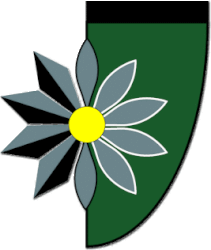
Kesteven and Sleaford High SchoolSelective Academy, commonly known as Kesteven and Sleaford High School (KSHS), is a selective school with academy status in Sleaford, an English market town in Lincolnshire. It caters for girls aged between eleven and sixteen in Years 7 to 11, and girls and boys aged sixteen to eighteen in its coeducational Sixth Form.
Heckington is a village and civil parish in the North Kesteven district of Lincolnshire, England. It is situated between Sleaford and Swineshead Bridge, and south of the A17 road. Heckington, with 1,491 households, is one of the largest villages in Lincolnshire. The population of the civil parish including Boughton was 3,353 at the 2011 census.
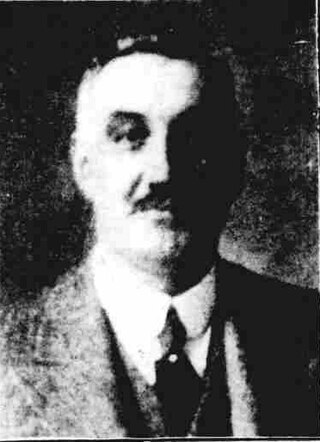
Samuel Pattinson was a British businessman and Liberal politician.

St George's Academy is a co-educational comprehensive secondary school based in the English market town of Sleaford in Lincolnshire, with a satellite school at nearby Ruskington.
Sleaford Joint Sixth Form (SJSF) is a partnership in Sleaford, England, between Carre's Grammar School, Kesteven and Sleaford High School and St George's Academy. It enables sixth-formers based at them to study individual courses offered at any of the schools. This makes provision more economical and gives students a choice of approximately 60 A-Level or Level 3 vocational courses.

Quarrington is a village and former civil parish, now part of the civil parish of Sleaford, in the North Kesteven district of Lincolnshire, England. The old village and its church lie approximately 1 miles (2 km) south-west from the centre of Sleaford. Suburban housing developments at New Quarrington and Quarrington Hill effectively link the two settlements. Bypassed by the A15, it is connected to Lincoln and Peterborough, as well as Newark and King's Lynn. At the 2011 census, Quarrington and Mareham ward, which incorporates most of the settlement, had an estimated population of 7,046.
Sir William Robertson Academy is a coeducational secondary school of around 1000 pupils, situated in Welbourn, near Lincoln, Lincolnshire, England. The school is sited on a former WWII munitions dump for the nearby Wellingore Aerodrome.
The Deanery of Lafford is an historic deanery in the Anglican Diocese of Lincoln in England. Located around the market town of Sleaford, it covers an area of c.200 square miles and serves a population of c.36,000.

St Andrew's Church is a Grade I listed Anglican parish church dedicated to Andrew the Apostle, in Billingborough, Lincolnshire, England. The church is 7 miles (11 km) south-east from Sleaford, and at the western edge of the Lincolnshire Fenlands.
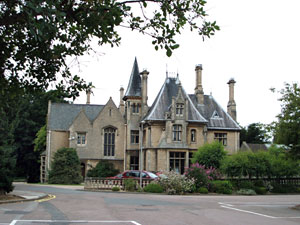
Westholme House is a historic building in the English market town of Sleaford in Lincolnshire, set in 32 acres of parkland and school grounds. Built around 1849 in the style of a French Gothic mansion by Charles Kirk for his business partner Thomas Parry, it was privately owned until the 1940s, when Kesteven County Council acquired the house and its grounds. It subsequently served as the county library and part of Sleaford Secondary Modern School. The stone house follows an asymmetrical layout and incorporates a range of Gothic elements in its design. In 1974, it was recorded in the National Heritage List for England as a designated Grade II listed building, recognising it as of "special interest".

The fifth set of elections to Kesteven County Council were held on Thursday, 7 March 1901. Kesteven was one of three divisions of the historic county of Lincolnshire in England; it consisted of the ancient wapentakes of Aswardhurn, Aveland, Beltisloe, Boothby Graffoe, Flaxwell, Langoe, Loveden, Ness, and Winnibriggs and Threo. The Local Government Act 1888 established Kesteven as an administrative county, governed by a Council; elections were held every three years from 1889, until it was abolished by the Local Government Act 1972, which established Lincolnshire County Council in its place.
Coteland's School Ruskington was a secondary-level community school in the village of Ruskington, Lincolnshire, accommodating pupils aged 11–16 through years 7 to 11. It formally opened as Ruskington Secondary Modern School in 1957, although teaching had begun the previous year. It federated with St George's College of Technology in nearby Sleaford in 2007, and then closed at the end of 2009 to allow the schools to merge into St George's Academy. The buildings and grounds were significantly redeveloped in 2012–2015 to serve as a satellite school for the academy.
References
- ↑ "The Lafford High School, Billinghay: Summary", EduBase (Department for Education). Retrieved 3 January 2017.
- ↑ "The Lafford High School, Billinghay: Establishment Details", EduBase (Department for Education). Retrieved 3 January 2017.
- ↑ Ward & Eden 2009 , pp. 34–35
- 1 2 "A New School Open at Billinghay", Sleaford Standard, 10 May 1963, p. 16.
- ↑ The Billinghay HORSA School (also called the Billinghay HORSA Centre) was in operation by 1948: "Where Are They Now?: Details of the Appointments Held by Some Former Students of the Bolton Training College", The Vocational Aspect of Secondary and Further Education, vol. 15, no. 30 (1963), p. 67; see also, notice regarding school re-openings in Sleaford Gazette, 15 September 1950, p. 4, col. 1. A workshop was added to the school in 1949. With the subsequent opening of new secondary schools at Ruskington and Branston, enrolment at the HORSA Centre fell, but it continued to serve local children and its workshop also provided lessons for pupils aged 11 to 13; see: "'Primary' Title is Deceiving", Sleaford Gazette, 30 June 1961, p. 10. The headteacher from 1951 until at least 1959 was Mr K. Hinchcliffe: "New Chairman for Youth Employment Committee", Sleaford Gazette, 3 July 1959, p. 2.
- ↑ "Events in 1946 in Retrospect", Sleaford Gazette, 27 December 1946, p. 3.
- ↑ "Primary and Secondary Education", Sleaford Gazette, 16 May 1947, p. 4.
- ↑ "Ministry Give Way on Secondary School at Billingborough", Sleaford Gazette, 28 November 1958, p. 9.
- 1 2 "Patient Efforts", Sleaford Standard, 7 July 1961, p. 10.
- ↑ "The First Day at a New School", Sleaford Standard, 26 April 1963, p. 24.
- ↑ "No Official Opening—And This Is Why", Lincolnshire Echo, 5 December 1963, p. 3.
- ↑ "A New School Open at Billinghay", Sleaford Standard, 10 May 1963, p. 16.
- ↑ "Governors and Staff", Sleaford Standard, 10 May 1963, p. 17.
- ↑ With the transfer of senior pupils to the Lafford School, Billinghay's two existing village schools (a boys' school and a girls' and infants' school) merged, with the boys' school closing and the new school being under a new headteacher, K. Hinchcliffe, who had previously been headteacher at the boys' school and before that the HORSA Centre: "Senior Girls Going to New School", Sleaford Standard, 19 April 1963, p. 26.
- ↑ "Pupils Face 17-Mile Bussing", Sleaford Standard, 19 July 1979, p. 3.
- ↑ "Split-Site School to Be Rebuilt" . Sleaford Standard. 13 September 1979. p. 1. Retrieved 18 April 2024– via British Newspaper Archive.
- ↑ "No Guarantees over School" . Sleaford Standard. 13 December 1979. p. 7. Retrieved 18 April 2024– via British Newspaper Archive.Lenton, Bob (13 December 1979). "The School Equation No-One Has Solved" . Sleaford Standard. p. 7. Retrieved 18 April 2024– via British Newspaper Archive.
- ↑ "Education Chairman Speaks out on Schools Controversy" . Sleaford Standard. 3 January 1980. p. 1. Retrieved 18 April 2024– via British Newspaper Archive. "School-Shuffle Support Refuted" . Sleaford Standard. 10 January 1980. p. 1. Retrieved 18 April 2024– via British Newspaper Archive.
- 1 2 Lenton, Bob (4 September 1980). "Parents Beat Big School Reshuffle". Sleaford Standard. p. 1. Retrieved 27 April 2024 – via British Newspaper Archive.
- 1 2 "£105,000 for School Growth", Sleaford Standard, 21 January 1982, p. 3.
- ↑ "[No title]", Sleaford Standard, 25 March 1982, p. 4, col. 7.
- ↑ "Planning Decisions", Sleaford Standard, 15 April 1982, p. 2.
- ↑ "Village School May Become House", Lincolnshire Echo , 7 August 1984, p. 6.
- ↑ "New Report Says Three at Risk", Sleaford Standard, 30 October 1986, p. 4.
- ↑ "Schools Axe Won't Fall", Sleaford Standard, 27 November 1986, p. 1.
- ↑ "Schools at Risk Again?", Sleaford Standard, 7 May 1987, p. 3.
- ↑ "Term Begins in Premises Built with Staff Ideas in Mind", Lincolnshire Echo , 22 September 1989, p. 3.
- 1 2 "Top Cook Opens up", Sleaford Standard, 26 January 1995, p. 12.
- ↑ "Education through the Years", Sleaford Standard, 12 October 1995, p. 12.
- 1 2 "Extra £70,000 to Improve School", Sleaford Standard, 11 January 2001, p. 3.
- ↑ "Small Secondary Schools to Shut?". Lincolnshire Echo. 27 April 2004. p. 3.
- 1 2 "Struggling School May Get New Headteacher". Lincolnshire Echo . 12 May 2005. p. 13.
- 1 2 3 4 "Lafford School Head Resigns". Sleaford Standard. 21 March 2008. Archived from the original on 16 December 2014. Retrieved 15 December 2014.
- 1 2 "Plans to Merge Schools into £24 Million Academy". Sleaford Standard. 4 April 2007. Archived from the original on 16 December 2014. Retrieved 15 December 2014.
- 1 2 "Head Calls It a Day after 13 Years". Sleaford Standard. 17 July 2007. Archived from the original on 16 December 2014. Retrieved 15 December 2014.
- ↑ "Ruskington Governors Agree to Join Schools Partnership". Sleaford Standard. 21 May 2007. Archived from the original on 16 December 2014. Retrieved 15 December 2014.
- ↑ "£300,000 Boost for Academy". Lincolnshire Echo . 14 November 2008. Retrieved 19 March 2015.
- ↑ "Lafford High is Nation's Most Improved School". Sleaford Standard. 8 March 2007. Archived from the original on 16 December 2014. Retrieved 15 December 2014.
- ↑ "'Vote of Confidence' for Schools over Exams". Sleaford Standard. 17 June 2008. Archived from the original on 16 December 2014. Retrieved 15 December 2014.
- ↑ "Lafford High: The Big GCSE Improvers!". Sleaford Standard. 16 January 2008. Archived from the original on 16 December 2014. Retrieved 15 December 2014.
- ↑ "St George's Cherry-Picked Star Pupils". Sleaford Standard. 13 March 2008. Archived from the original on 16 December 2014. Retrieved 15 December 2014.
- ↑ "Parents Reach Boiling Point". Sleaford Standard. 13 March 2008. Archived from the original on 16 December 2014. Retrieved 15 December 2014.
- ↑ "County High School to Close Doors", BBC News , 28 February 2008. Retrieved 25 April 2024.
- 1 2 "Welcome to Lafford High School", Lafford High School, archived from the original on 13 July 2010.
- ↑ "Fighting to Save Lafford School Buildings". Sleaford Standard. 13 July 2010. Archived from the original on 16 December 2014. Retrieved 15 December 2014.
- ↑ "The Lafford High School, Billinghay", UK Government. Retrieved 25 April 2024.
- ↑ "Bid to Block Sale of Former School Land", Lincolnshire Live, 17 June 2016. Retrieved 25 April 2024.
- 1 2 3 4 5 "Headmaster is A.A.A. Coach", Sleaford Standard, 10 May 1963, p. 17.
- ↑ "From Newark to Leadenham", Grantham Journal , 25 November 1960, p. 4.
- ↑ "School's out", Sleaford Standard, 6 August 1981, p. 7.
- ↑ "Births, Marriages and Deaths", Sleaford Standard, 11 August 1988, p. 2.
- 1 2 "Two New Head Take Over", Sleaford Standard, 13 August 1981, p. 4.
- 1 2 "Taking Rotary into the Next Century", Grantham Journal, 25 July 1997, p. 37.
- ↑ "Special Farewell", Sleaford Target, 2 April 1997, p. 5.
- ↑ "All Change", Sleaford Target, 7 July 1999, p. 6.
- ↑ "Ex-Head Is Rotary President", Newark Advertiser , 9 July 1999, p. 15.
- ↑ "News from 1997", Centre for Studies on Inclusive Education . Retrieved 28 April 2024. Quoting Sleaford Standard, 20 November 1997.
- ↑ "Schools to Bale out Music Cut?", Sleaford Standard, 29 January 1998, p. 5.
- ↑ "New Head at Lafford", Sleaford Target, 1 July 1998, p. 2.
- ↑ Inspection Report: The Lafford High School (Ofsted: 2001), p. 7.
- ↑ Inspection Report: The Lafford High School (Ofsted: 2001), pp. 1, 7.
- 1 2 "Students Can Take Pride in Their Achievements", Sleaford Standard, 4 December 2002, p. 25.
- ↑ Taylor's name was spelt "Martin" in the newspaper announcing his appointment at Lafford, but was otherwise spelt "Martyn", e.g. in "Students Can Take Pride in Their Achievements", Sleaford Standard, 4 December 2002, p. 25, and David Martin, "Joining the Book Club", The Times (London), 15 May 2003 (retrieved 8 May 2024).
- ↑ "Headteacher Appointed at Billinghay", Sleaford Standard, 27 June 2002, p. 2.
- ↑ "Paul Frederick Watson". Companies House. Retrieved 21 October 2015.
- ↑ "Taking College into Next Century" . Sleaford Standard. 17 September 1998. p. 11. Retrieved 18 April 2024– via British Newspaper Archive.
- ↑ "Principal Nominated as Teacher of the Year". St George's Academy. 27 February 2014. Retrieved 10 April 2015.
- ↑ "Brief History". St George's College of Technology. Archived from the original on 11 December 2009.
- ↑ "Re: Principal Appointment" (PDF). St George's Academy. 27 February 2014. Archived from the original (PDF) on 4 March 2016.
- ↑ "Lafford Pupils Say 'Save Our School' (Lincs Echo)", Lincolnshire Echo (Youtube, 5 May 2008) at 9:14. Retrieved 28 April 2024.
- ↑ Stuart Butler